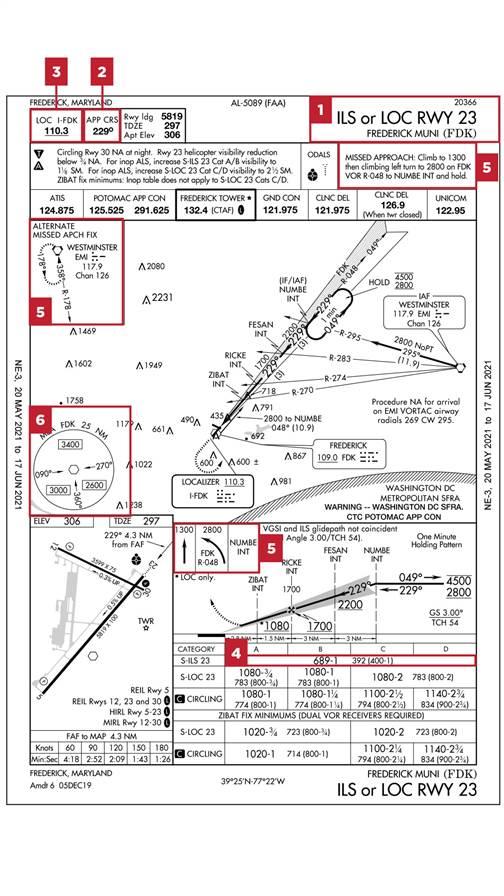Instrument Tip: Putting the brief in briefing
Tips for approach plate briefings
 Instrument approach procedure charts are little powerhouses of information. They are packed with maps and diagrams in at least five forms, include multiple frequencies, and are a guide for normal, abnormal, and emergency operations. That’s a lot to ask of such a small piece of paper. To become familiar with the information and make sure the procedure is flown properly, we’re trained to brief the approach. Like many pilots, I was taught to brief the entire thing. It was like story time for my kids. I would start at the top and read out the entire plate. It wasn’t until training to become an instrument flight instructor that someone showed me a better way.
Instrument approach procedure charts are little powerhouses of information. They are packed with maps and diagrams in at least five forms, include multiple frequencies, and are a guide for normal, abnormal, and emergency operations. That’s a lot to ask of such a small piece of paper. To become familiar with the information and make sure the procedure is flown properly, we’re trained to brief the approach. Like many pilots, I was taught to brief the entire thing. It was like story time for my kids. I would start at the top and read out the entire plate. It wasn’t until training to become an instrument flight instructor that someone showed me a better way.
Rather than taking the plate as one solid story, the instructor encouraged me to focus on only the most important information. Ultimately we’re most concerned that it’s the right approach, how we get to the runway, how low we can go, what happens if we go missed, and what happens in an emergency. I’ve since evolved from that list to thinking of plates as I do other charts. Sectional charts give us layers of information, including topography, manmade physical structures, navigation, and airspace and other rules. Plates are similar. The information can be explored in layers or stages.
Pre-approach
Once ATC assigns or you request a procedure, get to work immediately preparing yourself and the aircraft. Pull out the paper or call it up on your tablet. Always confirm that you have the right one. Read it off the top of the plate and say it aloud. “We’re doing the ILS 23 to Frederick.” Then start the set-up.
Plates have a bunch of information that can be used in a checklist/do list scenario well in advance of hitting the final approach fix. Unless someone has really bungled it up, you should have time at least 20 or 30 miles out to set up communication and navigation frequencies, set up the approach, verify the weather, double check the landing distance, runway lights, and where you expect to turn off and park. Set all this up in your navigators and radios as a do list, and then run it as a checklist. Start at the top of the plate and verify that the tower or common traffic advisory frequency is standby in your primary radio, the final approach frequency is your active, and ground is active in your second radio. Verify the navigation is all correct, including anything you’ll need for step-down fixes, and that the GPS and nav are synced and in the correct mode. Verify headings are correct and you’re on the feeder you expect and how you’ll intercept the final approach course. This is the checklist stage.
With that part of the approach already handled, much of the plate becomes extraneous information and not part of any briefing. At this point maybe you’re cruising along a few miles from intercepting the final approach course and you have a minute to relax as you wait. This is a good time to do the briefing.
Keep this part short because most of us can’t remember anything beyond seven items, and in a high workload environment like an approach, it could be even fewer. Here’s one possible roadmap:
- Confirm the approach. You can’t do this too many times. Say aloud the approach, runway, and airport, and verify in the GPS that it’s what you expect.
- Final approach course. Again verify the final heading to the runway.
- Nav to the runway. Ensure the VOR or GPS is set to the final approach segment as you expect.
- Minimums. Read the minimums you’ll expect to abide by. This is even more important if you’re planning to circle, or on a GPS approach with multiple minimums listed.
- Missed approach procedure. Read aloud the climb and initial turn. Some people read the entire procedure, some stick to only the climb and turn, knowing that the other items can be verified later.
- Emergency. What happens in an emergency? Will you go missed? Climb to the minimum safe altitude? Verify the information and have a plan.
With all that information, the briefing will be short and to the point. It may sound something like this:
“Today we’re flying the ILS 23 to Frederick. It is loaded and activated in the GPS. The final approach course is 229 degrees, 110.3 is set to nav 1, and we have CDI mode on the GPS. We’re going down to 690 feet [who can remember 689?] If we don’t see the runway we’ll climb to 1,300 feet and then turn left while climbing to 3,000 feet direct to the Westminster VORTAC [in this case, the alternate missed approach procedure, by notam]. If anything happens and we need to climb, 3,400 feet will keep us clear of all obstacles.”
This type of briefing takes about 30 seconds. By thinking of the plate in layers we can strip out all the other information and use it as a guide to set up the airplane, our radios, and our expectations many minutes prior. Then when the time comes for the final, critical pieces of information, we can brief only what really matters.



